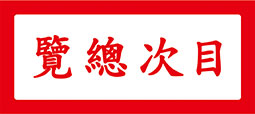It has been eighty five years since the Marco Polo Bridge Incident which broke out on 7th July in the 26th year of the Republic (1937). At that time, the Japanese Army used the pretext of a missing soldier to deploy themselves outside Wan-p’ing City, and demanded the right to enter and search. Chi Hsing-wen (吉星文), commander of the 29th regiment assigned to defend Wan-p’ing City, refused to comply. On 8th July the following day, the Japanese Army attacked the city and dictated that the Chinese regiment must withdraw from the Marco Polo Bridge. Chi directed the troops to battle the Japanese. The War of Resistance Against Japan began. On 17th July, Chairman Chiang Kai-shek made a speech at Lu-shan, considered to be the manifestation of the spirit of the War of Resistance Against Japan. It partially reads:
“At a time when China is seeking peace in foreign policy, and striving for unity in domestic policy, the Marco Polo Bridge Incident suddenly occurred. Not only are people across the country distressed and incensed, international public opinion is also shocked………
Concerning the Marco Polo Bridge Incident, the government has formulated a consistent direction and position. We will unequivocally use our full power to sustain this position. We hope for peace, yet we do not pursue temporary security. We ready ourselves for war, yet we do not want war. When the country enters war, we know that our predicament will be a sacrifice to the finish, there is not even the slightest fortuity of circumvention. The moment the war starts, there is no geographic difference between those from the south and those from the north, there is no demographic difference between those who are old and those who are young, no matter who we are, we will bear the responsibility to protect our country in the War of Resistance Against Japan. We will all resolve to sacrifice everything we have.”
Overseas Chinese then realized the mortal danger China was facing. Some returned to join the army, some supported the National Government financially, within which was the task of building the air force, especially critical for the outcome of war. The historian Shang Ssu-t’u wrote the story of the Overseas Chinese Patriotic Aviation Bond, a testament to Chinese determination to protect the country in the War of Resistance Against Japan. This determination was borne not only by those from the south and the north, but also by those living overseas in other countries.
Curatorial and Editorial Department

Patriotic Aviation Bond in 100 U.S. Dollars denomination
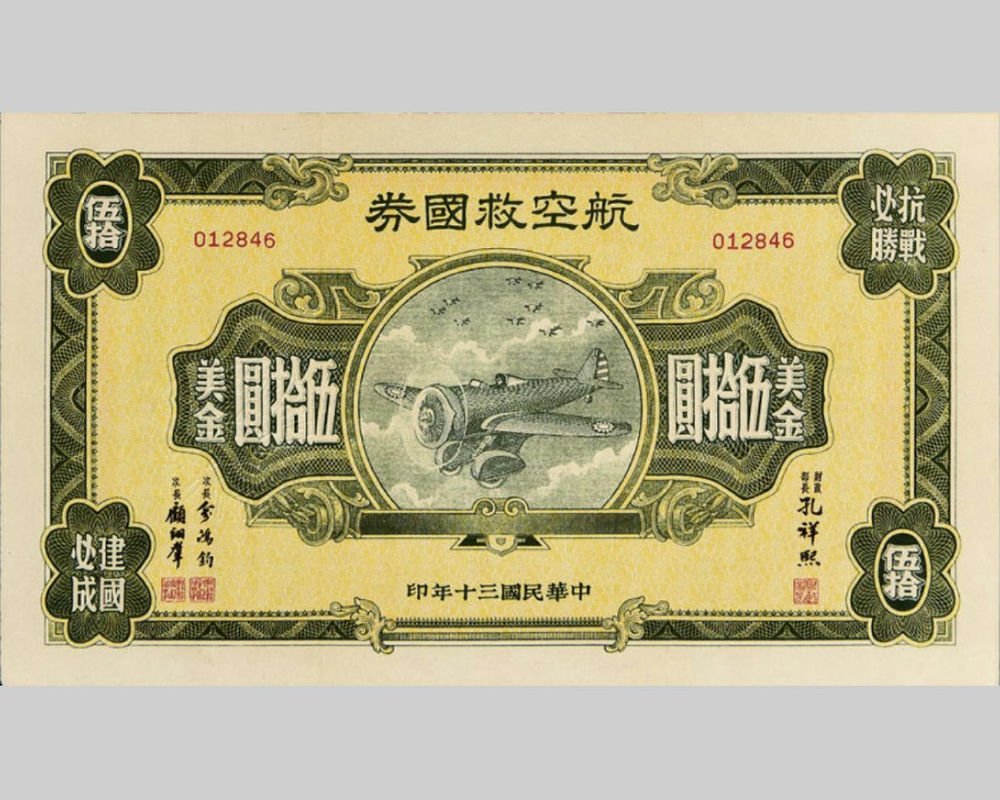
Patriotic Aviation Bond in 50 U.S. Dollars denomination
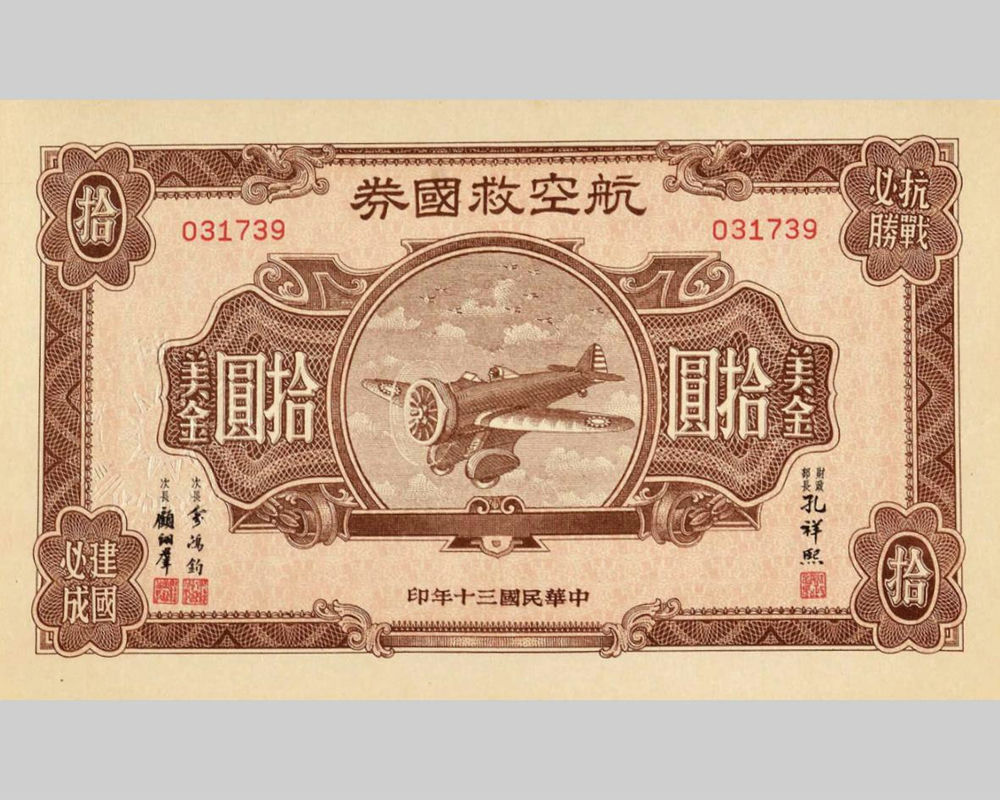
Patriotic Aviation Bond in 10 U.S. Dollars denomination

Patriotic Aviation Bond in 5 U.S. Dollars denomination
Those who frequent antiquarian book stores will occasionally come across vintage Patriotic Aviation Bonds in the denomination of United States Dollars. They were issued in 1940 during the early years of the Republic.
The format of the bonds are 11.5 cm in width and 19 cm in length. There are four denominations, five dollars, ten dollars, fifty dollars and one hundred dollars. Their colours are black, brown, green and red respectively. At the top of each bond, there are five Chinese characters in clerical script: Hang-k’ung chiu-kuo ch’üan (航空救國券 Patriotic Aviation Bond). In the middle is a vignette of the Boeing P-26 fighter aircraft. On the upper right corner, there are four Chinese characters: K’ung-chan pi-sheng (抗戰必勝 Victory will prevail in the War of Resistance against Japan), on the lower left corner, there are four Chinese characters: Chien-kuo pi-ch’eng (建國必成 Nation building will succeed). Near the lower right and lower left corners are the three signatures and personal seal impressions of the finance minister K’ung Hsiang-hsi (孔祥熙 1880-1967), the deputy finance minister Yü Hung-chün (俞鴻鈞 1898-1960) and another deputy finance minister Ku I-ch’ ün (顧翊群 b. 1900). Printed at the back of the bonds are the General Regulations of the Patriotic Aviation Bond, with a list of six regulations.
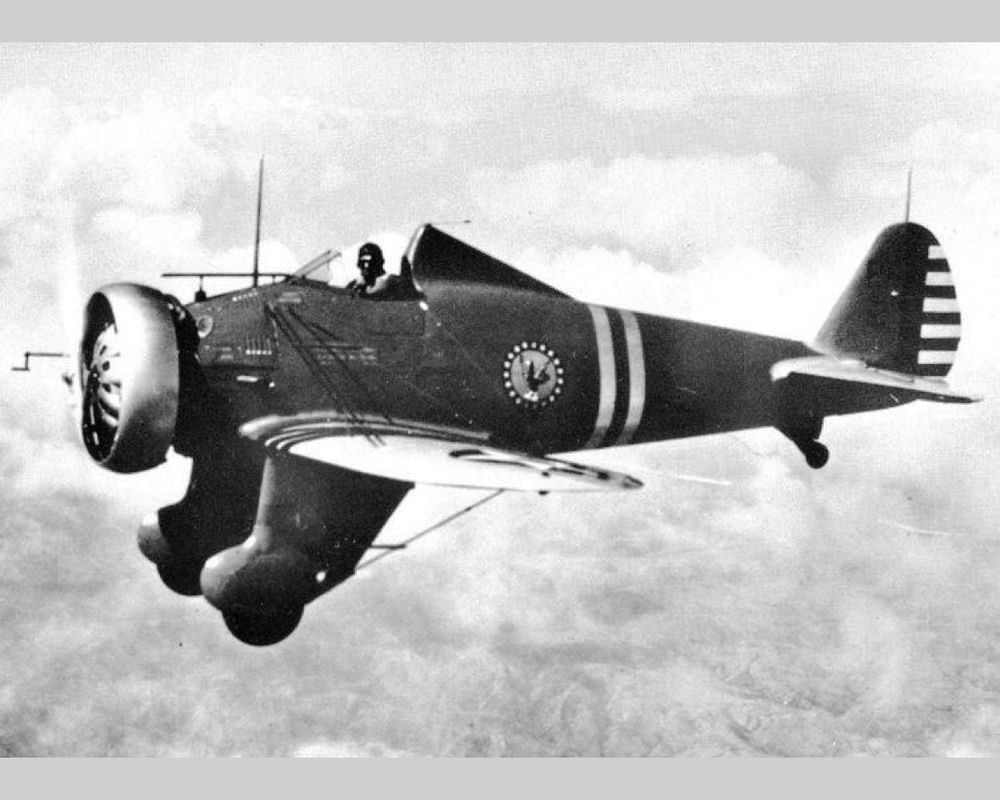
Image of the Boeing P-26 adorns the Patriotic Aviation Bond. The Republic of China Air Force purchased and deployed the American manufactured Boeing P-26 in small numbers.
Even before the Hsin-hai Revolution (辛亥革命) in 1911 that toppled the Ch’ing dynasty, Dr. Sun Yat-sen, Father of the Republic, while on his travels in America, Britain, France, Germany, Japan and others to propagate revolution and to observe the political and military affairs of these countries, he was already aware that the Wright brothers had flown the first motor-operated airplane. In the ensuing years, he envisioned the growing importance of aviation, and gradually formulated the view of its military application.
From a broad perspective, the issue of the Patriotic Aviation Bond is related to the campaign of Birthday Celebration and Fundraising for Warplanes in October 1936. The date of 31st October 1936 was the 50th birthday of Chiang Kai-shek, chairman of the Central Military Commission. The time coincided with the Two Guangs Incident which was settled in July 1936, and the dissent of the Southwest Political Committee which was also resolved in July. The country was enjoying a period of short lived peace, to be shattered in the following year when Japan attacked China and started the Sino-Japanese War. Ch’en Kuo-fu (陳果夫 1892-1951), chairman of Kiangsu Province, first suggested the campaign of Birthday Celebration and Fundraising for Warplanes. On 23rd September he proposed to Ho Ying-ch’in (何應欽 1890-1987) the defense minister:
“It is best to initiate donations from all quarters to purchase military aircrafts as birthday gifts for the Chairman of the Central Military Commission. This can also reinforce national defense.”
This was positively received by Ho Ying-ch’in, for it allowed blatant acquisition of armaments in public and the nurturing of patriotism throughout the country. At a highly sensitive time of Sino-Japanese relationship, the meaningfulness of this event was obvious. Subsequently Ch’en Kuo-fu initiated fundraising activities in Kiangsu Province, and trailing tightly behind were fundraising activities in many other provinces. A series of grand events related to Birthday Celebration and Fundraising for Warplanes rolled out across the country.
On 24th October 1936, a ceremony to christen the fighter aircrafts purchased through donations by Shanghai residents took place at Lung-hua Airport. The airport was packed with over one hundred thousand people, and the scene was exceptionally stupendous. At ten o’clock in the morning, Lung-hua Road was already filled with people. After midday, more and more people converged. Traffic came to a standstill, cars crawled one after the other like bullock carts, and a considerable number of drivers had to abandon their vehicles to walk. At the ceremony, ten military aircrafts of the latest model purchased through donations from Shanghai residents were on display. They were parked in a neat row in front of the newly constructed VIP stage at the northern end of the airport. The fuselages of the planes were painted leaf green, the tail fins painted in alternate colour strips of blue and white. The lengths of the planes were approximately over six meters. They were biplane fighters, their individual names painted on either side near the front, and the National Emblems painted on the upper wings. Around the aircrafts stood armed police and military police on close guard. Apart from Wu T’ieh-ch’eng (吳鐵城 1888-1953), mayor of Shanghai, Huang Ping-heng (黃秉衡 1901-1989), representative of the Aviation Commission, the other eminent men who attended the ceremony were Chu Min-i (褚民誼), T’an Chen (覃振), Yang Hu (楊虎), Ts’ai Chin-chün (蔡勁軍), Sung Hsi-lien (宋希濂), Tu Yüeh-sheng (杜月笙), Wang Hsiao-lai (王曉籟), Yü Ch’ia-ch’ing (虞洽卿) and others. There were aerobatic performances during the ceremony, the most enthralling was carried out by the “Flying Socialite” Li Hsia-ch’ing (李霞卿 1912-1998) who flew freestyle. The audience was dazzled, clapping thunderously, cheering and leaping in excitement.
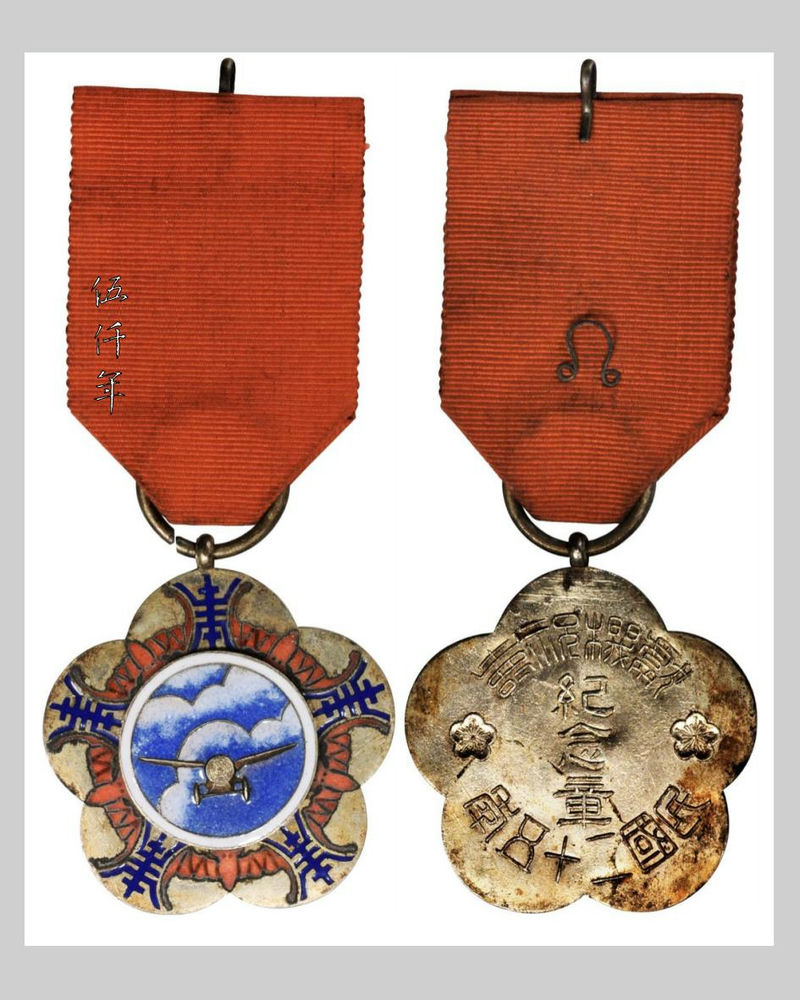
Front and back of commemoration medal of Birthday Celebration and Fundraising for Warplanes, awarded in the 25th year of the Republic (1936)
At nine o’clock in the morning on 31st October 1936, Nanking organized the Ceremony of Chairman Chiang’s Birthday Celebration and Fundraising for Warplanes. The ceremony took place at the Ming-ku-kung Airport whereby three raised platforms were constructed, and in the middle was the VIP stage. The front facade of the VIP stage was decorated with patterns of pine branches and flowers, the stage skirting consisted of blue, white and red fabric strips. There were a pair of tall birthday calligraphy couplets on the two sides of the VIP stage. At the top was a large model of aircraft, on either side was a small model of aircraft. There were banners with the characters t’ung-i (統一 unification) and chiu-kuo (救國 save the country). In the middle of the VIP stage hung a portrait of Dr. Sun Yat-sen, a colourful birthday plaque with pine decoration was located below the portrait. According to contemporary accounts, over two hundred thousand people attended the ceremony at Ming-ku-kung Airport. Aerobatic performances began around nine forty five in the morning. A large group of aircrafts appeared in the blue sky above the airport. Thirty six aircrafts methodically formed the characters Chung-cheng (中正), the original Chinese name of Chiang Kai-shek. After circling the sky for some time, they flew towards the city centre of Nanking. In an interval of approximately ten minutes, there appeared two groups of aircrafts that flew above the VIP stage to form the character wu (五), meaning five. They flew at low level, swept across the audience, and scattered birthday leaflets in the air. Afterwards, the two groups of aircrafts continued their aerobatic performances of rotations, falling and diving like comets, as well as shooting up like arrows.

The Pictorial Review of Generalissimo Chiang Kai-shek’s Military and Political Career (In Celebration of his Fiftieth Birthday), published in 1936
On 31st October 1936, many newspapers published a long article over two thousand words Wu-shih sheng-jih kan-yen: Pao-kuo yü ssu-ch’in (五十生日之感言:報國與思親 Thoughts on My 50th Birthday: To Serve the Country and To Reminisce About My Parents) by Chiang Kai-shek. In this article he wrote that he would “strive to fulfill the ultimate sacrifice for the country should circumstances demand.” The sincerity he expressed is touching.
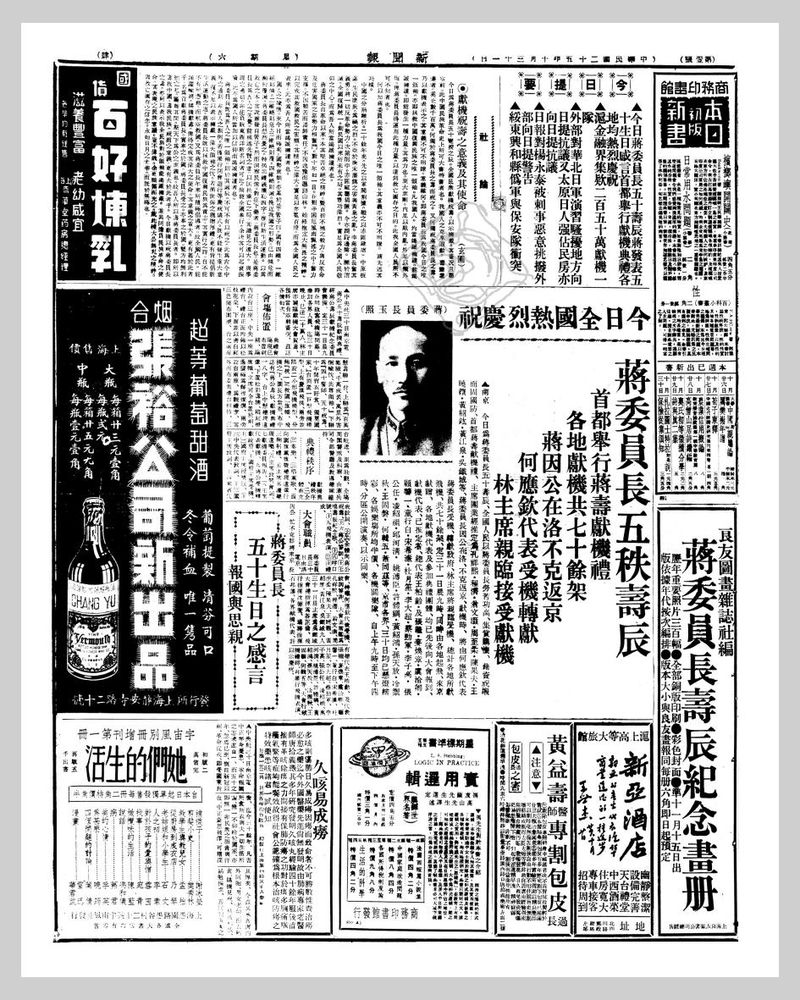
Hsin-wen Pao Newspaper caption on 31 October 1936: “50th Birthday of Chairman Chiang. Capital Organized Birthday Celebration and Fundraising for Warplanes. Over Seventy Aircrafts Donated by Citizens.”
Other related articles published on that day are: Message to the Nation Regarding Chairman Chiang’s 50th Birthday Celebration and Fundraising for Warplanes from the Central Publicity Department; National Celebration of Chiang’s Birthday, Grand Ceremony of Fundraising for Warplanes in the Capital from Ta-kung Pao Newspaper in Shanghai; Special Issue of Chairman Chiang’s Birthday Celebration and Fundraising for Warplanes from Hsin-wen Pao Newspaper. The Special Issue consisted of many articles, including those by Wu T’ieh-ch’eng, Yü Fei-p’eng (俞飛鵬 1884-1966), Shao Yüan-ch’ung (邵元沖 1890-1936) and others. The title of the article by Wu T’ieh-ch’eng is Concentrate National Resources and Support the Leader for the Survival of the Chinese Race (集中國力擁護領袖以求民族之生存). It was a banquet speech celebrating the 50th birthday of Chiang Kai-shek for the Association of Physical Education for National Defense in Shanghai. He spoke about Chiang Kai-shek in terms of “The Rescuer of the Nation and Race who persisted despite trials and tribulations”. He also spoke about patriotism in terms of “A national spirit that is enthusiastically championed by all Chinese”, that “It was thoroughly displayed a few days ago during the ceremony to christen the warplanes of the Chung-cheng squadron in Shanghai.” Furthermore the Special Issue published numerous slogans, such as : “Birthday Celebration and Fundraising for Warplanes is Support for the Leader to Realize National Salvation through Aviation! ” and “For the Cause of National Reinvigoration All Chinese Should Continue to Donate and Purchase Warplanes!”
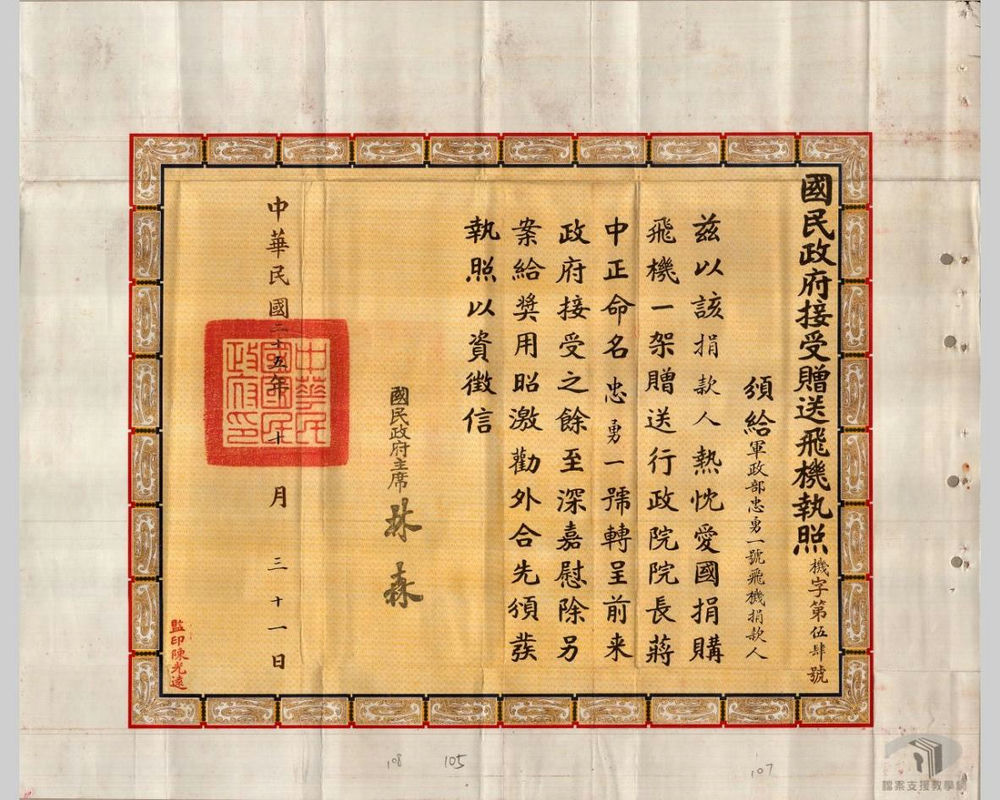
License to Accept Warplane Donation by the National Government presented on 31 October in the 25th year of the Republic (1936)
The issue of the Patriotic Aviation Bond in 1940 by the National Government originated from an order by Chiang Kai-shek to the Central Overseas Department. The purpose was to launch the Overseas Chinese Aviation Campaign for China, and to advance Overseas Chinese aviation education. The original plan was to raise five million U.S. Dollars, however because of the ardent response from Overseas Chinese who fervently purchased these bonds, they were greatly oversubscribed. The campaign was a resounding success.
According to the 20th December edition of Cheng Yien Pao Newspaper, after the issue of the Patriotic Aviation Bond in the United States and the Philippines, Overseas Chinese from these and other countries purchased bonds worth over seven million U.S. Dollars in less than one year. Overseas Chinese who purchased the bonds in North America and South America alone numbered 300,000. One can conceive their patriotic fervor.
In 1941 the Republic of China Air Force purchased from America the Curtiss P-40 Tomahawk fighter aircrafts. At that time, America sold this aircraft to Britain for the price of 36,000 U.S. Dollars each. As the Patriotic Aviation Bond had raised over seven million U.S. Dollars, assuming the sum of seven million for the purpose of calculation, the Republic of China Air Force could purchase 194 Curtiss P-40 Tomahawk aircrafts with this amount. This is evidence of the huge contributions made by Overseas Chinese in the War of Resistance Against Japan.
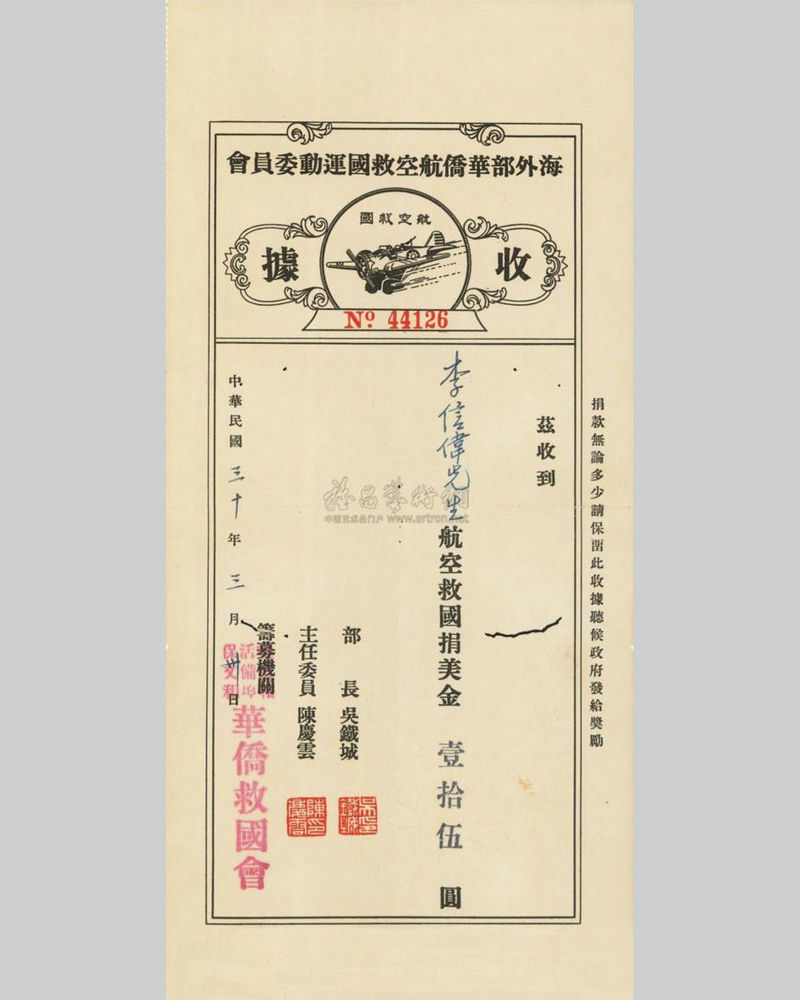
Donation receipt from the Committee on Overseas Chinese Aviation Campaign for China of the Central Overseas Department dated 30 March 1941
Attached is the 2nd February 1940 telegram from Wu T’ieh-ch’eng, minister of the Central Overseas Department, to Chairman Chiang Kai-shek of the Executive Yuan. It reads:
“Dear Chairman Chiang of the Executive Yuan in Chungking:
Your instruction was received earlier regarding the launch of the Overseas Chinese Aviation Campaign for China and the related issues of donations.
I have acted in accordance with your wish to draft the methods to launch the Overseas Chinese Aviation Campaign for China with a total of ten articles. They have been submitted for your approval. I have also promptly received the telegram coded keng shih mi yü and numbered 9122 from yourself, stating:
‘The methods to launch the Overseas Chinese Aviation Campaign for China have been reviewed. They are viable and they should be approved for implementation. I hope this can be conveyed to Director Chou of the Aviation Commission. Ch’en Ch’ing-yün, director counselor, should be appointed to oversee this.’
I have acted in accordance with your wish in its preparation. For easier liaison of Overseas Chinese, a Committee on Overseas Chinese Aviation Campaign for China has been set up at the Hong Kong Branch of the Central Overseas Department. Ch’en Ch’ing-yün, Lin Fu-yüan, Cheng Ping-chung, Ch’en Zhuo-lin, Li Ssu-yüan, Feng Pai-li, Ch’en Yen-sheng have been appointed committee members and Ch’en Ch’ing-yün the chairman. They will proceed within a fixed date to be effective. The committee members will be sent to different ports in America, to raise significant funds, and these will be deposited at the Bank of China in America for the purchase of military aircrafts. After investigation, since the War of Resistance Against Japan, we have already asked Overseas Chinese to donate enormous sums, if we ask them to donate again, there is cause for worry that it is beyond the means of Overseas Chinese, hence we plan to borrow the money with the issue of the Patriotic Aviation Bonds, aiming for five million to ten million U.S. Dollars. When the war ends, the remaining money from the Patriotic Aviation Bonds can be distributed in installments within five years by drawing lots. Apart from seeking your perusal, enclosed are a copy each of the Methods to Launch the Overseas Chinese Aviation Campaign for China, Articles of Association of the Committee on Overseas Chinese Aviation Campaign for China of the Central Overseas Department, General Regulations of the Overseas Chinese Patriotic Aviation Bond, Incentives of the Overseas Chinese Patriotic Aviation Bond, and a specimen of the Overseas Chinese Patriotic Aviation Bond. Hoping that they will all be approved and filed.
Wu T’ieh-ch’eng, minister of the Overseas Department”
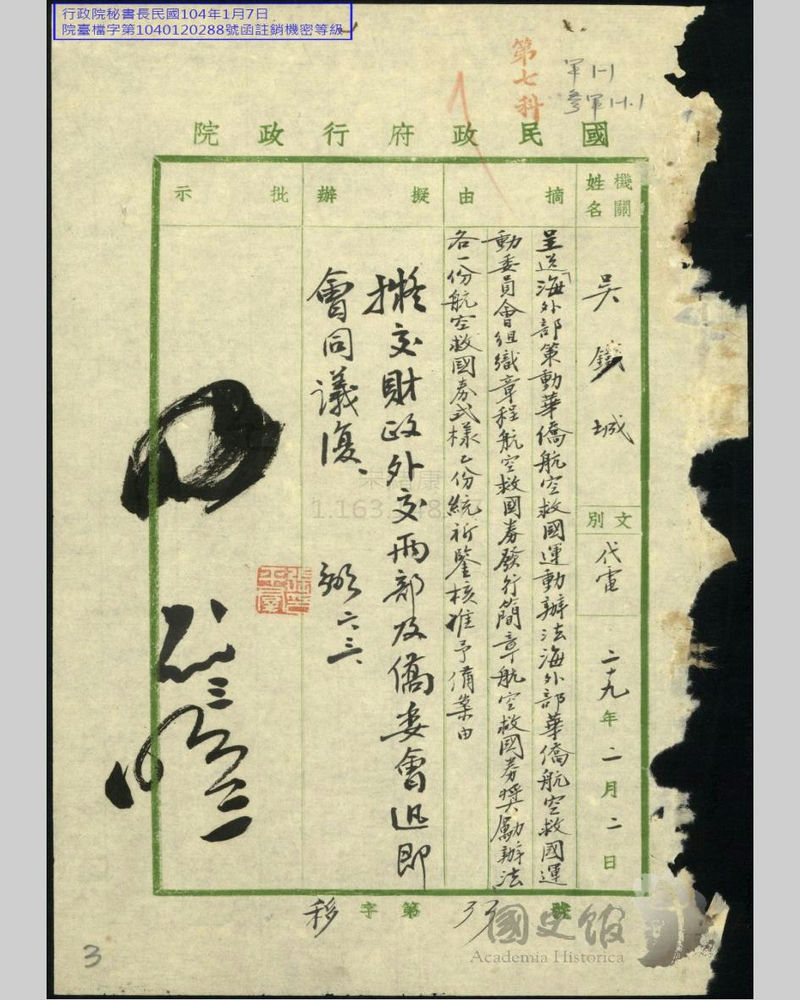
Cover of telegram manuscript from Wu T’ieh-ch’eng, minister of the Central Overseas Department, to Chiang Kai-sheik, Chairman of the Executive Yuan, regarding the issue of the Overseas Chinese Patriotic Aviation Bond, dated 2nd February in the 29th year of the Republic (1940)
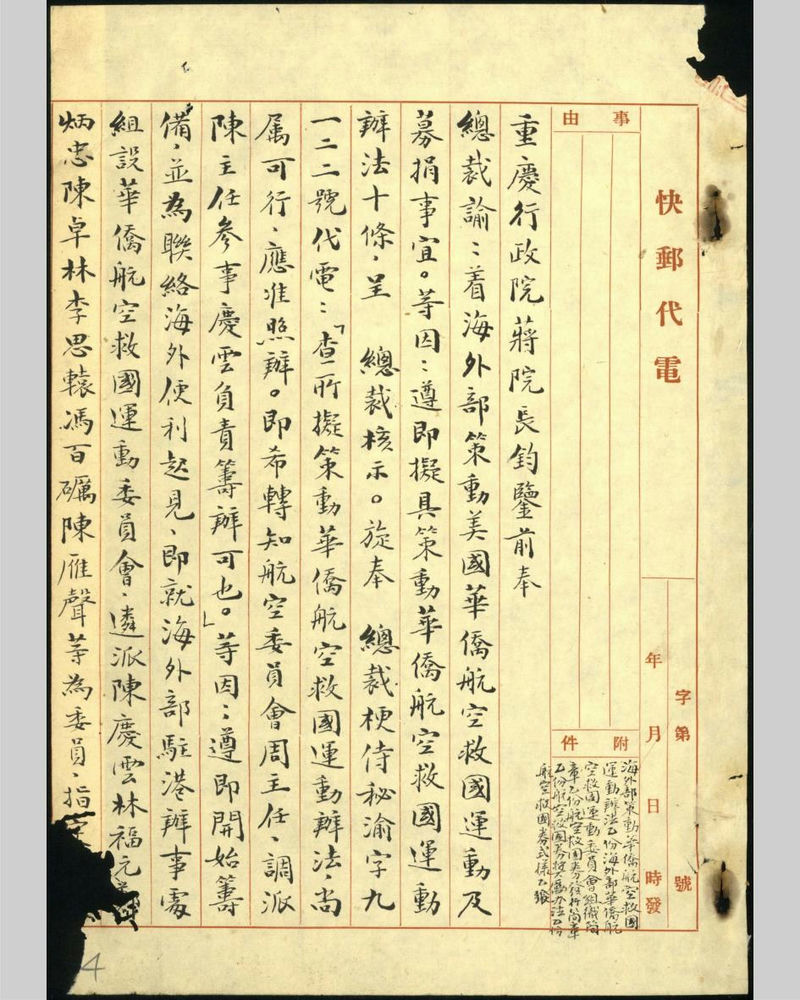
First page of telegram manuscript from Wu T’ieh-ch’eng, minister of the Central Overseas Department, to Chiang Kai-sheik, Chairman of the Executive Yuan, regarding the issue of the Overseas Chinese Patriotic Aviation Bond, dated 2nd February in the 29th year of the Republic (1940)
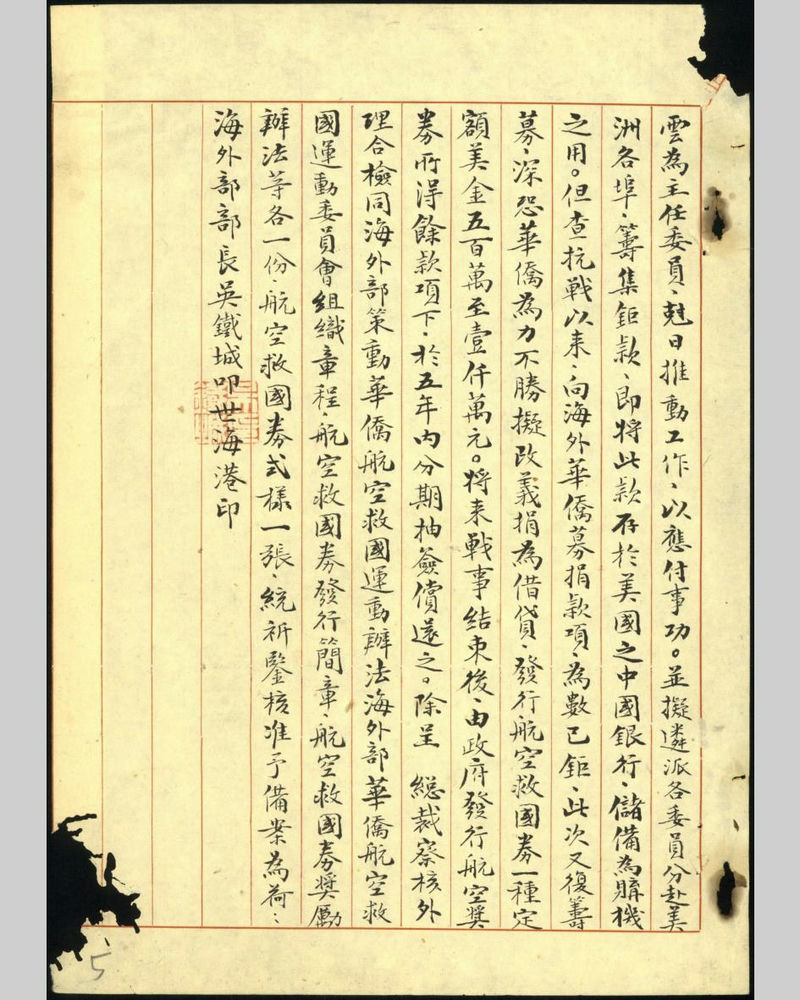
Second page of telegram manuscript from Wu T’ieh-ch’eng, minister of the Central Overseas Department, to Chiang Kai-sheik, Chairman of the Executive Yuan, regarding the issue of the Overseas Chinese Patriotic Aviation Bond, dated 2 February in the 29th year of the Republic (1940)
